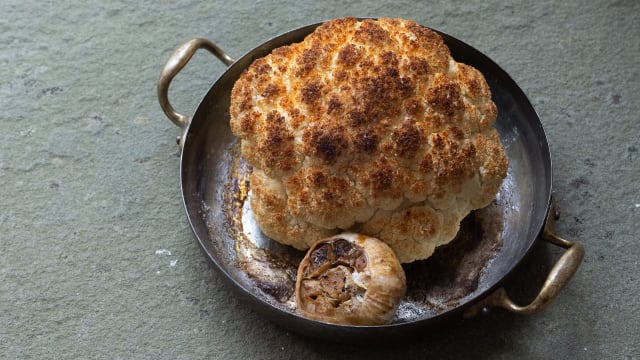Cauliflower

Latin name: Brassica oleracea
Uses: vegetable
What is cauliflower?
Cauliflower was originally just a humble cabbage like its fellow head-forming crucifers. But through centuries of human intervention, it has become the new It Girl of the vegetable world. Why, might you ask? Cauliflower is often white, and doesn’t have a ton of flavor, but what it can do is masquerade as all kinds of things: pizza crust, rice, even Buffalo chicken. But you shouldn’t love cauliflower for what it could be — you should love it for what it already is.
Why is cauliflower healthy?
It is hard to top the versatility, health, and nutrition benefits of cauliflower. Among edible plants, it offers one of the largest sources of phenolic compounds. These extensively studied anti-inflammatory compounds have been found to help reduce cancer, heart disease, brain disease, and hormonal imbalances.
What does cauliflower taste like?
Cauliflower’s curd-like florets have a lovely dense-crunchy texture and vegetal, nutty-sweet flavor. We’re sorry to report that it does not taste or feel anything like rice, but if you need a low-carb pile of crumbly white substrate for your curries and stir-fries, knock yourself out.
Long-stemmed Chinese flowering cauliflower, fractal-psychedelic Romanesco, and yellow-orange, green, and purple varieties taste the same as the regular stuff, but colorful food is always more nutritious (and fun!). It’s best to eat cauliflower right away, before it gets brown spots and starts smelling bad.
How do I use cauliflower?
No crudités platter is complete without cauliflower florets, but there’s so much more you can do with it. Steam and mash cauliflower as an alternative to potatoes (for best results, blend with cream and butter into a silky purée) or take a tip from Indian cuisine and pair cauliflower with potatoes for aloo gobi. Cauliflower also loves being pickled. Use it for oily/spicy giardiniera, pickle it in a turmeric- and ginger-spiked vinegar brine, or add it to pickled beets to turn it bright pink.
Roasted florets are sponges for sauces and bold seasoning; use this to your advantage and add cauliflower to flavorful bean dishes and winter salads. If you can find Chinese “flowering” cauliflower in Asian grocery stores, grab some — its longer stems and smaller florets make it ideal for soaking up chile oil in a stir-fry.
Cauliflower is a great centerpiece for plant-based meals. Try roasting the whole head with garlicky parmesan breadcrumbs; grill 2-inch-thick slab “steaks” and then brush them with herby chimichurri sauce; toss fat florets in melted butter and Buffalo sauce and broil them (be sure and serve with celery sticks and blue cheese dressing).
What does cauliflower pair well with?
Like its cousin broccoli, cauliflower loves a gratin with cheddar cheese sauce and does well in frittatas. It loves spice blends like those used from North Africa all the way through to Southeast Asia, so be sure to include it in your tagines and curries.
Where does cauliflower grow?
The Brassica crops that eventually became cauliflower originated around the Mediterranean, with cultivars coming from Ancient Rome around 2,500 years ago. Fast-growing varieties are generally sown in the spring, but cauliflower can also be planted in summer for a fall/winter crop.
Fun cauliflower fact:
We tend to think of cauliflower as a monolith with maybe a dozen or so varieties for gardeners, but in Arthur Alger Crozier’s 1891 monograph The Cauliflower, there are an astonishing 140 cauliflower varieties listed.


